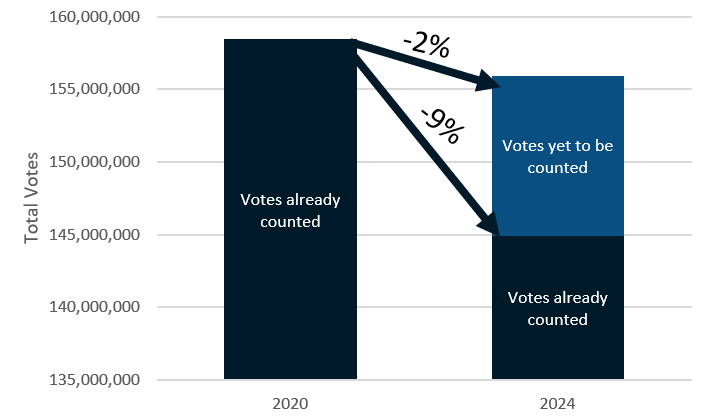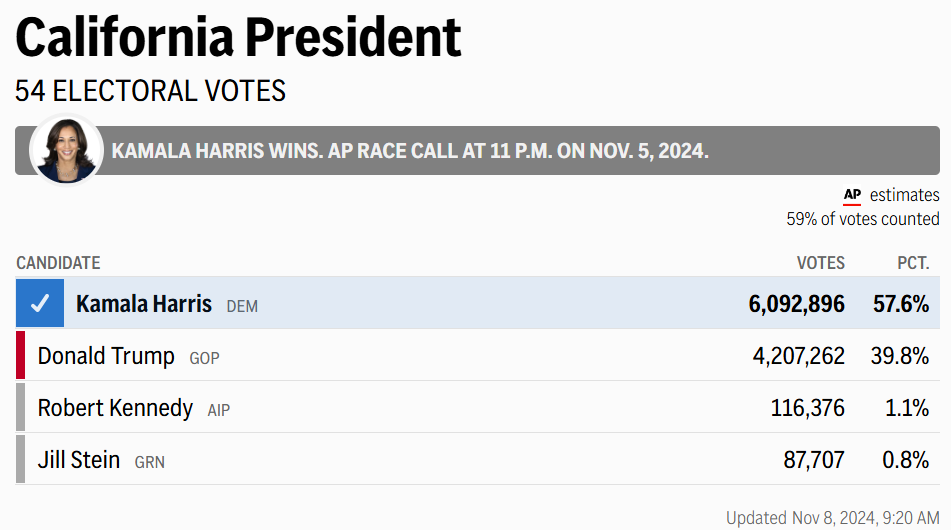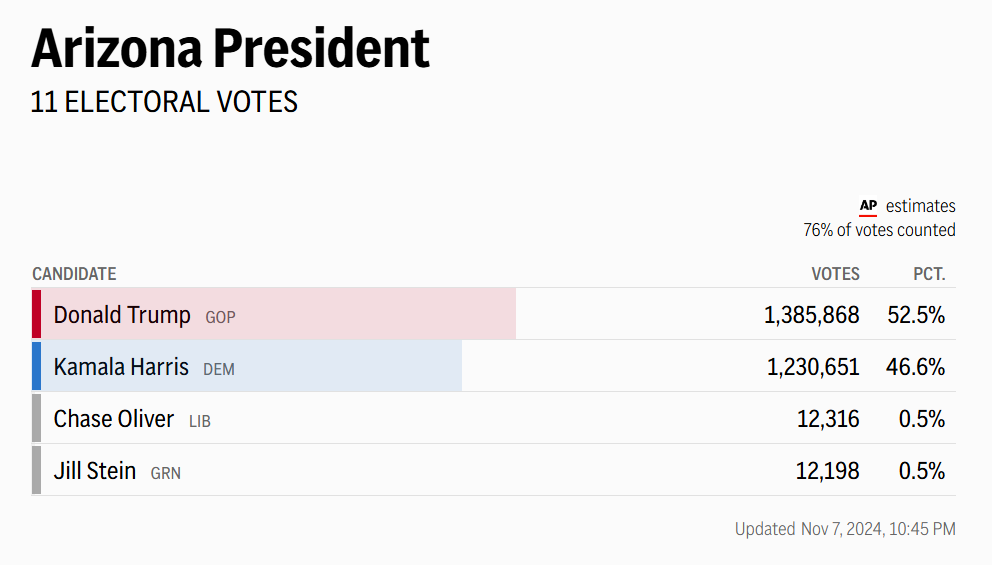UPDATE: Checking on Ballot Counts -- 20 Million Missing Ballots in 2024 Compared to 2020?
The gap is actually 2.5 million votes, approximately
I will give away the answer at the top, and not make you wait:
the drop in votes between 2020 and 2024 is about 2.5 million votes, not 20 million.
I decided to add in a graph to make it more obvious.
People are looking at the graph with only the votes already counted (and mainly they were looking at older graphs, with fewer votes.) It was a larger drop than 9% originally.
You can scroll down to the bottom to see how this is figured, grab my spreadsheet, etc.
From November 7:
No, there are not nearly 20 million ‘unaccounted for’ votes
The Associated Press declared former President Donald Trump the winner of the 2024 presidential election Wednesday morning after it projected Trump to win enough states to secure the 270 votes needed for a majority in the electoral college.
Several people began questioning the vote count in viral social media posts just a few hours later. They compared the vote count at the time the AP called the race to the vote of the 2020 presidential election and questioned how this election could potentially have record turnout while being 18 million votes shy of the 2020 total.
Some people said those nearly 20 million votes were “unaccounted for.”
….
WHAT WE FOUND
While it’s true that the vote count of the 2024 presidential election as of Wednesday afternoon is nearly 20 million votes shy of the total vote for the 2020 presidential election, that’s because many states, most of which aren’t swing states, are still counting millions of ballots.
Using the current AP estimate of the percent of votes counted, VERIFY found that 20 of the 50 states, plus Washington, D.C., still have more than 16.2 million ballots left to be counted as of Wednesday afternoon.
At the time of VERIFY’s count, there were 16.7 million fewer votes than the final total cast for Biden and Trump in the 2020 presidential election.
Most of the states that are still counting a significant number of ballots have already been called for a candidate due to statistical analysis. The uncounted ballots will therefore not change the results of the Electoral College.
For example, the state with the most votes left to count, California, still has over 8.3 million votes to count, or 46% of its estimated total votes cast, according to the AP. Many of these remaining ballots are in cities and suburbs that typically favor Democrats. Although California’s remaining ballots may help Harris pull closer to or even surpass Trump’s popular vote count, these remaining ballots will not impact the result of the electoral college because California has already been projected as a Harris victory.
The state with the next most uncounted ballots, Washington, which has 1.5 million remaining ballots, is similar to California: most of the remaining ballots are in the Democratic-leaning Seattle metro area, but the state has already been projected to go to Harris.
And, I skipped over it, but here is the editor’s note from the top:
Editor's Note: As of 12:15 p.m. EST on Thursday, Nov. 7, there are still approximately 14 million ballots left to be counted.
The rest of this post is explaining the concepts of getting to the 2.5 million vote gap. It is based on certain assumptions, and I’m using AP News’s own reported votes and completion factors.
Totals to compare
The Federal Election Commission (FEC) says 158,429,631 votes were cast for president in 2020. It’ll be some time before we get the official numbers, but the University of Florida’s Election Lab estimates that just about that number of ballots will again be counted in 2024.
As of 10:45amET on 8 Nov 2024: AP News has these totals
Kamala Harris: 69,139,448 votes (47.7%)
Donald Trump: 73,478,969 votes (50.7%)
That’s 142,618,417 votes, but that’s only 98.4%, so 100% must be 144,937,416
That gives us a difference of 13.5 million from the 158.4 million vote total.
So far.
Vote Cast But Not Yet Counted = IBNR
We’ve had this issue before, with COVID (and other) deaths.
In insurance, we have the concept of IBNR, incurred but not yet reported.
Actuaries know that for deaths, accidents, insurance losses, etc., there is a lag between the occurrence (when it is incurred) that will cause an insurance claim to be made and the insurance company finding out about it (when it is reported).
So, we will set up an IBNR reserve for that situation. How we make that estimate differs by line of business, and we do incorporate external information.
For instance, when we hear about a large hurricane that goes through a territory, actuaries will look at the book of business for the company, consider the exposure in that territory, and usually use a factor estimating how much loss per building (if it’s homeowner’s insurance) to reserve for.
Once, when I worked for a life reinsurer and a massive earthquake hit a particular country, I had to estimate what might be claimed on our book of life insurance policies from that event. Zero was not an appropriate reserve. (It turned out nobody claimed, but it still was not appropriate to reserve 0.)
Now, there are other reserves, such as when the loss is reported, but we don’t know what the final amount will be paid — another one is “incurred but not enough reported” — we will have “completion factors”.
We actuaries might look at an earthquake event and assume only 30% of the losses have been reported at a particular point. We will use the losses already reported to develop the full claim reserve with a “completion factor” of 30%.
We do something similar with estimating number of uncounted ballots.
How to estimate the number of missing votes
For elections, the states, in general, know how many ballots were voted on election day itself. If there was early voting, they’d know how many of those ballots were voted.
They’d know how many mail-in ballots were sent out, and depending on the state, there may be a period that people are allowed to send the ballots back (needs to be postmarked by election day or something like that). So they may not know how many absentee ballots they’ll get back; they’d just know an upper bound.
Now, the media that are estimating number of votes may be looking at how many votes are coming in at various sites and what they’re reporting for turnout. Or perhaps the states are telling them what the completion rates are.
So, as of 9amET (ish), this is what AP news reports at the percentage of votes counted (I’m including all with counts under 95%)
California: 59%
Arizona: 76%
Utah: 76%
Alaska: 77%
Oregon: 81%
Colorado: 83%
Maryland: 83%
Washington: 86%
DC: 87%
New Jersey: 94%
All other states have completion factors of 95% or higher. They would provide missing votes as well, but have less of an impact.
California gap
California is the most populous state on this list, and has the lowest percentage completion. Let’s look at the count for California:
That’s 10,504,241 votes already counted.
If that’s only 59% of California’s votes, then 100% must be 17,803,798. (you divide the 10.5 million by 59%).
That would be an increase of 7.3 million votes right there, to close the gap.
With California counted, the gap would now shrink to 6.2 million votes less in 2024 than 2020.
Arizona gap
That’s 2,641,033 votes already counted.
If that’s only 76%, that means there’s 3,475,043 votes total in Arizona.
Then the gap shrinks again by 834,010 votes (the difference between the total and those already counted).
Now down to 5.4 million votes less after both California and Arizona are added.
As we go down the list, the gap to be shaved off gets less and less, but now we don’t have an eye-popping 20 million votes “lost”, but simply fewer voters than 2020, but still a lot more voters than 2016.
Rather than show each state one-by-one, let me give you the table of all those states.
Final result of estimated votes to be counted: 11 million
So, about 11 million votes yet to be counted. There will also be some votes yet to be counted in the other states.
13.5 million - 11 million… just a 2.5 million vote gap to explain.
Not 20 million.
That’s it.
It will be very easy to explain 2.5 million fewer votes, especially if one looks at which states where votes went down, and which where they went up.
(I will wait for that analysis.)
People need to cool their jets, as some of us older folks say.







Regarding whether it's more appropriate to count a total ballot gap or a Harris ballot gap:
One of ways fraud was alleged was the use of voting machines that were easily hacked. It was PROVED in a Kansas county that a voting machine flipped the votes for small race, for example.
So a similar vote total of the sum of Harris and Trump votes does nothing to "debunk" claims that votes were flipped from Trump to Harris.
The latest overall total (12:20PM Central time) is that Kamala Harris has a 12.1 million "ballot gap" from Biden's 2020 totals. Trump's totals are only 0.7 million below what he had in 2020.
I have been putting together a spreadsheet of my own to calculate the "Harris ballot gap", since I haven't been able to find anyone else's spreadsheet or chart to borrow. I did borrow wikipedia's chart from the 2020 election as a starting place.
My spreadsheet has data from some states dating from Wednesday night, some from last night and some from this morning. If I add up the numbers I have inputted from each state, Harris's votes are 120,000 "out of date" in total. I just updated the highest population states you mentioned above that have low vote counting completion percentages. That said:
The "Harris ballot gap" for California is 5,013,630 with 57.6% of the vote counted. By the way, last night California was shown as having 58% of the vote counted. California is a disgrace. Anyway, if we were to assume that the remaining ballots go the same percentage to each candidate, Harris would get 4.5 million more votes.
That leaves a 7.6 million Harris "vote gap".
Let's remember what the 2020 election turned on.
Trump lost Arizona by less than 11,000 votes - 11 electoral votes.
Trump lost Georgia by less than 12,000 votes - 16 electoral votes.
Trump lost Wisconsin by less than 21,000 votes - 10 electoral votes.
If those had gone to Trump the election would have been a 269-269 tie in the electoral college.
Trump lost Pennsylvania by 80,555 votes - 20 electoral votes.
I didn't think about the election being stolen in 2020, or 2021 or 2022. It wasn't until 2023 when I saw "2000 Mules", saw Mike Lindell's video, and saw the charts of the votes in those states in the middle of the night that started to understand what happened.
Mail in ballots are inherently insecure. In the last 10 years or so many states started allowing ANYONE to cast a mail in ballot, whereas previously it was only available to overseas military and people who couldn't come to voting polls. California and other states no longer require photo ID to vote. We need secure elections.